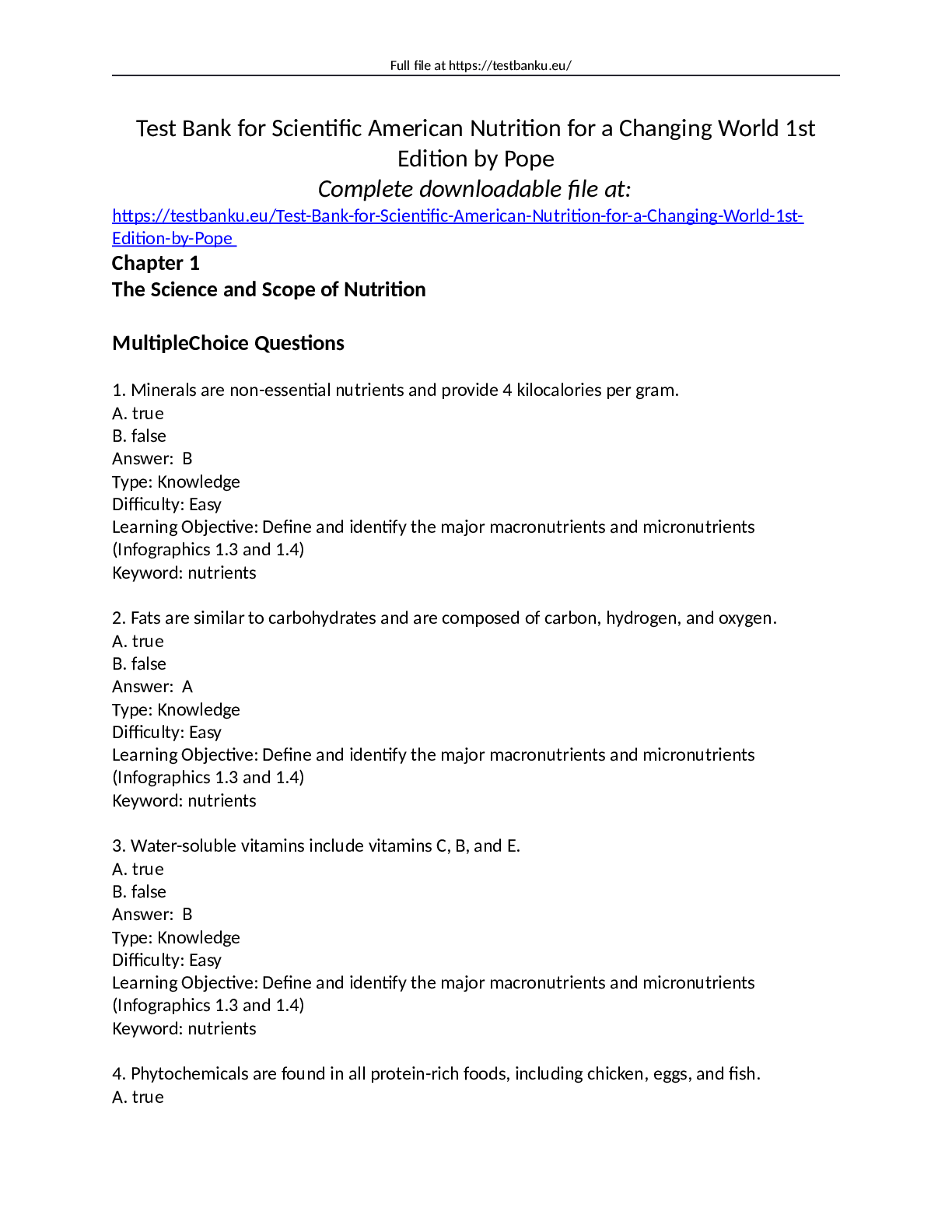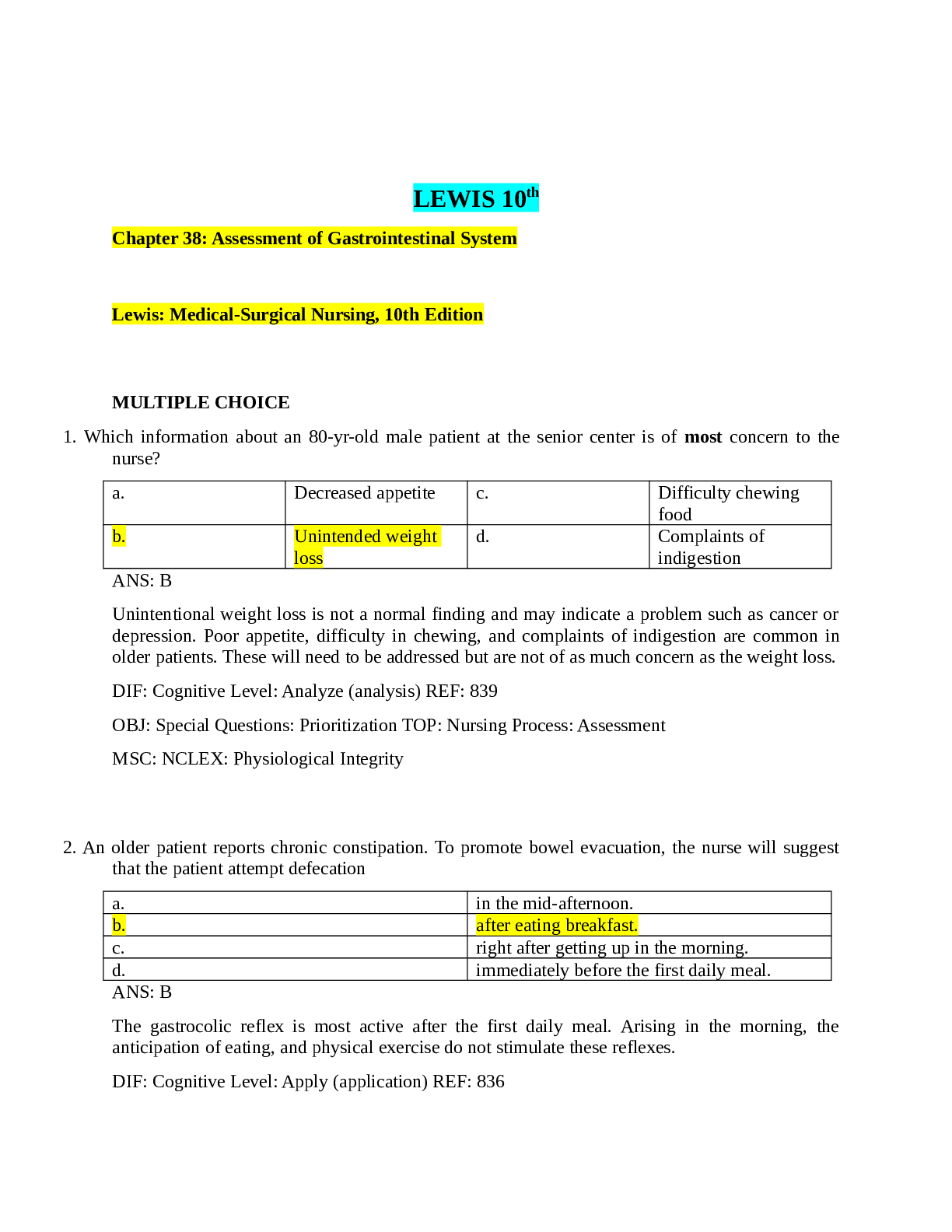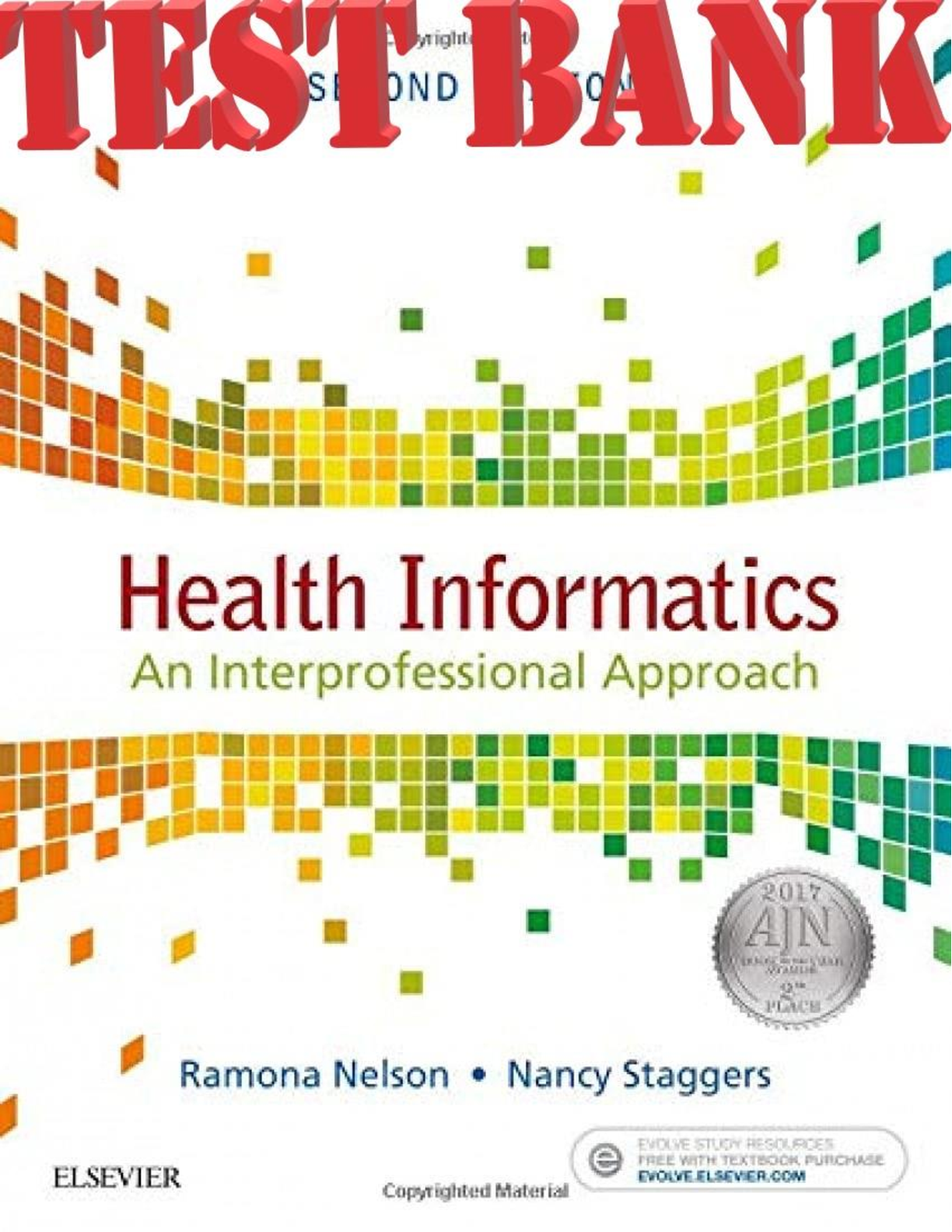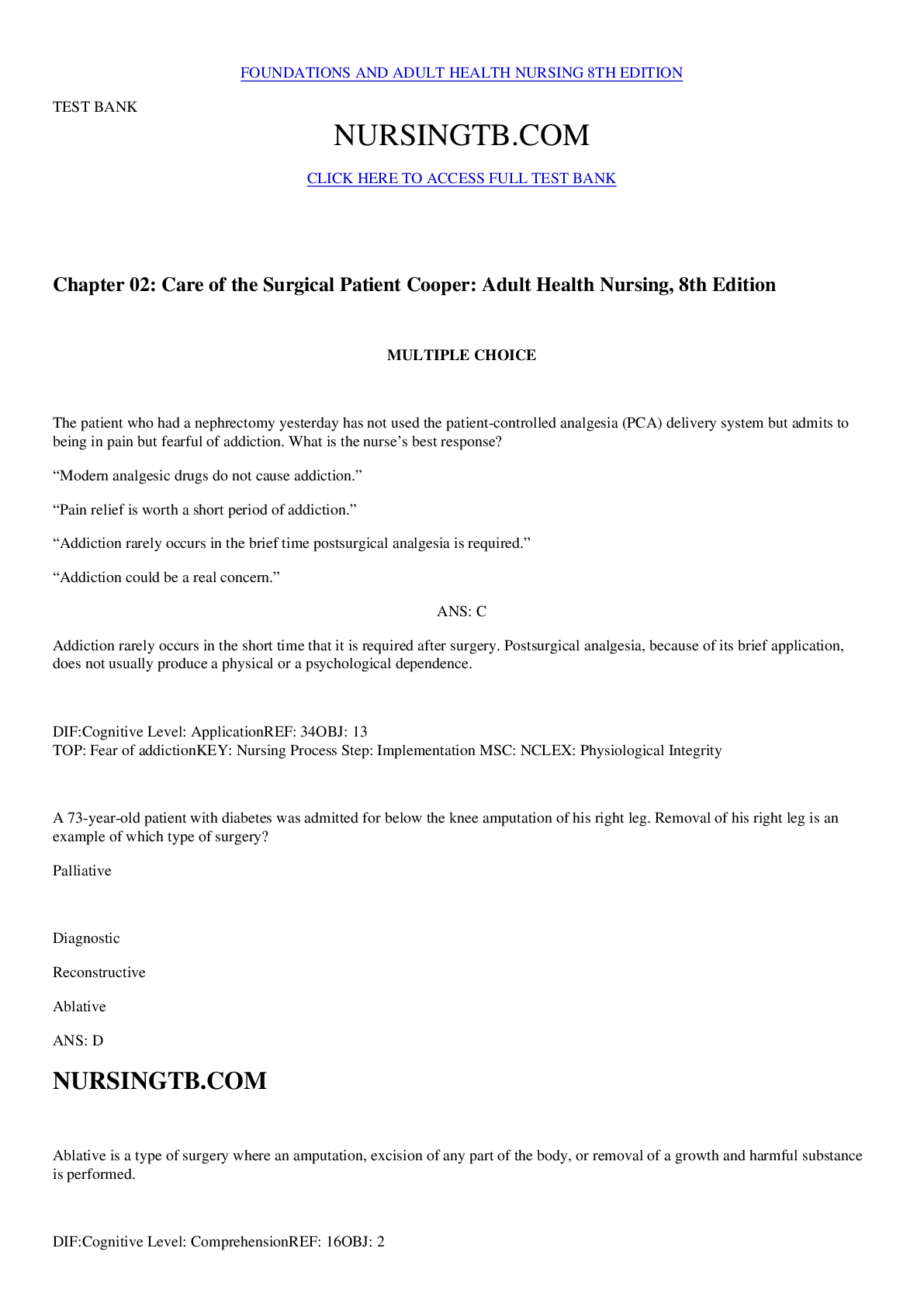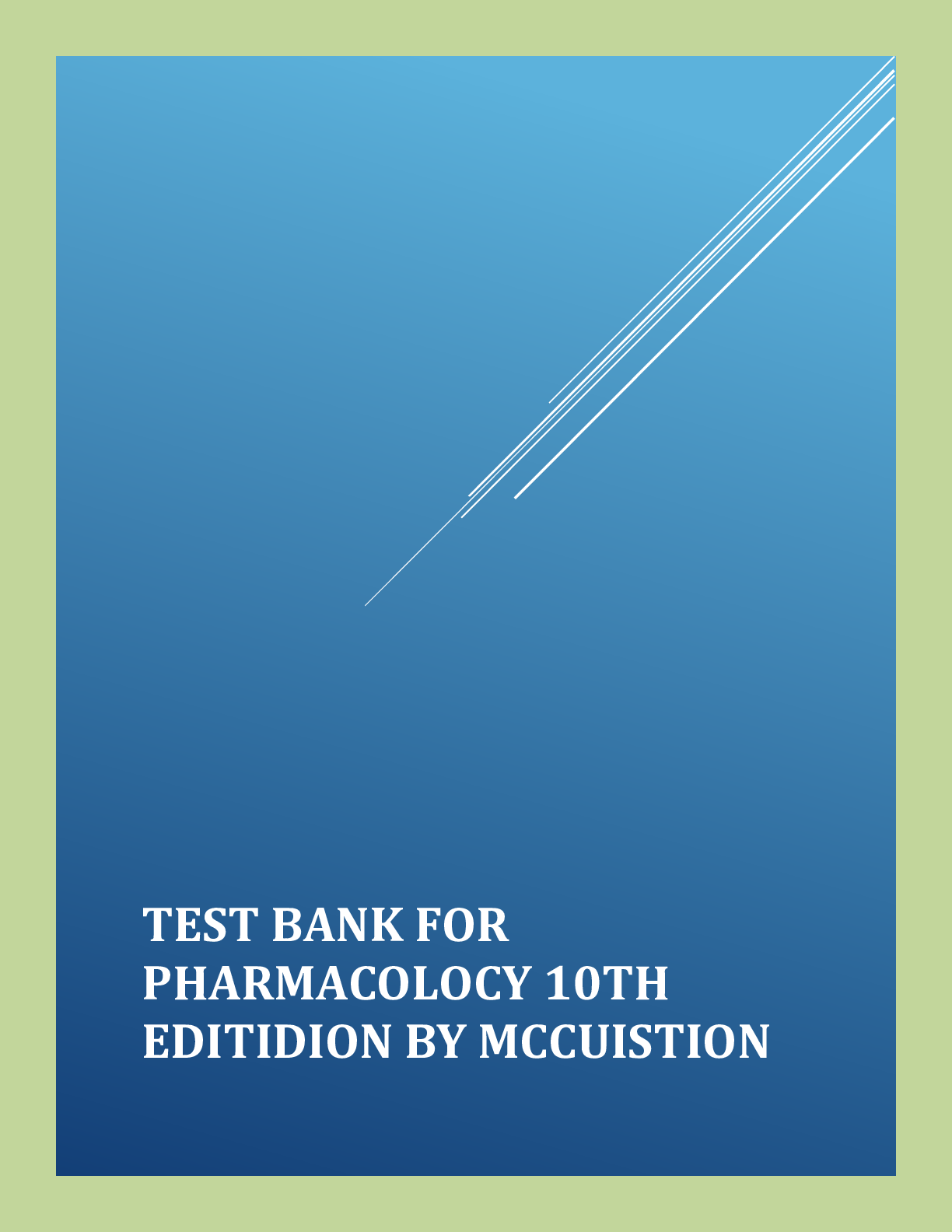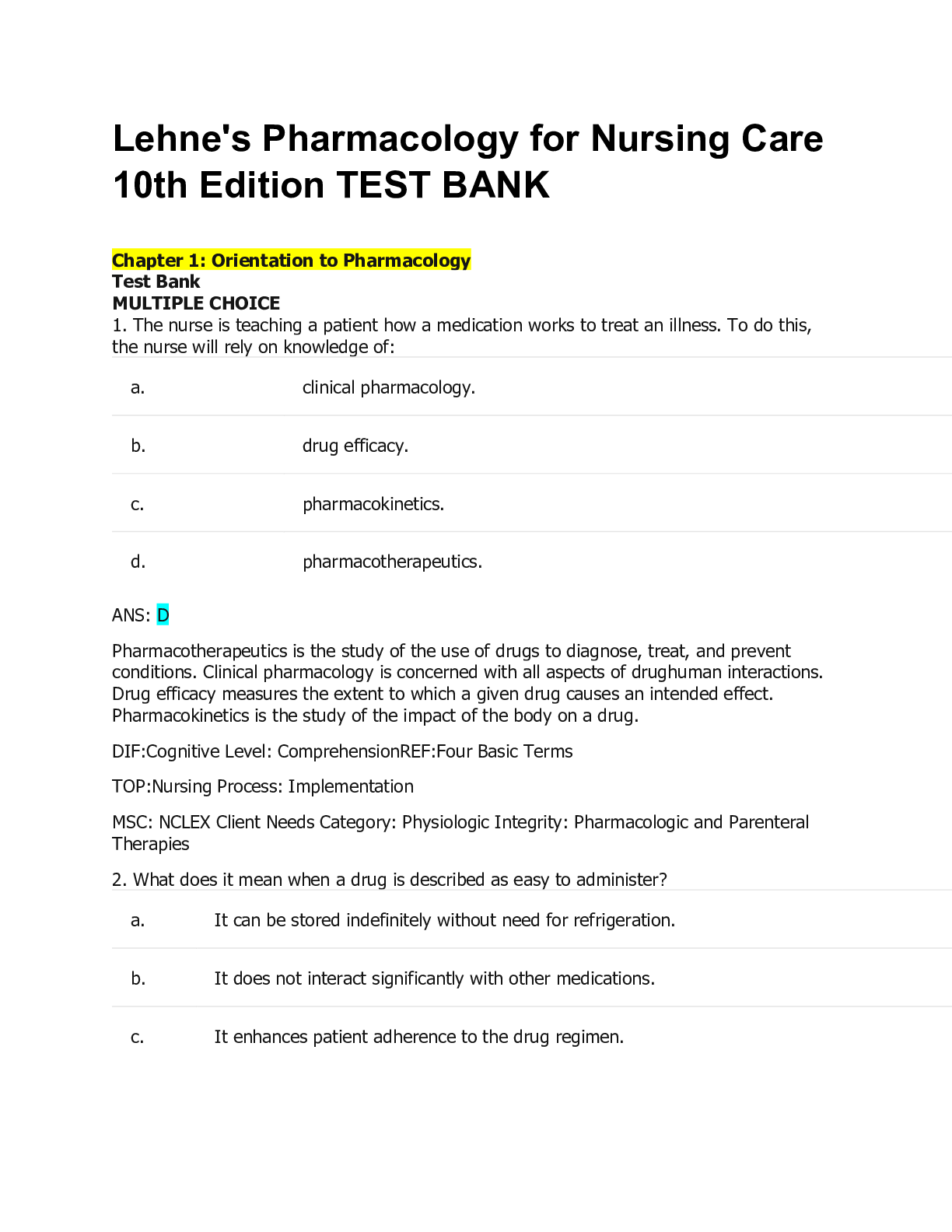*NURSING > TEST BANK > Burns Pediatric Primary Care 7th Edition All Chapters Complete Test Bank (All)
Burns Pediatric Primary Care 7th Edition All Chapters Complete Test Bank
Document Content and Description Below
Burns' Pediatric Primary Care 7th Edition Test Bank Chapter 1: Health Status of Children: Global and National Perspectives 1. Which region globally has the highest infant mortality rate? A. Indone... sia B. Southern Asia C. SubSaharan Africa Correct D. Syria 2. The primary care pediatric nurse practitioner understands that, to achieve the greatest worldwide reduction in child mortality from pneumonia and diarrhea, which intervention is most effective? A. Antibiotics B. Optimal nutrition C. Vaccinations Correct D. Water purification 3. Which is true about the health status of children in the United States? . 13348413856 A. Globalism has relatively little impact on child health measures in the U.S. B. Obesity rates among 2to5yearolds have shown a recent significant decrease. Correct . C. The rate of household poverty is lower than in other economically developed nations. D. Young children who attend preschool or day care have higher food insecurity. 4. The primary care pediatric nurse practitioner understands that a major child health outcome associated with worldwide climate change is A. cost of living. B. education. C. nutrition. Correct D. pollution. 5. When providing well child care for an infant in the first year of life, the primary care pediatric nurse practitioner is adhering to the most recent American Academy of PediatricsRecommendations for Preventive Pediatric Health Care guidelines by A. focusing less on development and more on illness prevention and nutrition. B. following guidelines established by theBright Futures publication. C. scheduling wellbaby visits to coincide with key developmental milestones. Correct D. seeing the infant at ages 2, 4, 6, and 12 months when immunizations are due. Chapter 2. Unique Issues in Pediatrics 1. A nurse is explaining the therapeutic milieu to a new nurse. The best explanation of this term would be: 1. The place where the child is receiving care. 2. Group therapy. 3. Personal interactions between patients and staff. 4. All of the above are correct. ANS: 4 2. A 16-year-old male has received a pink-slip from the police for inpatient psychiatric treatment. The teen has been expressing thoughts of hanging himself because Life sucks. The nursing staff should consider placing the child: 1. With peers. 2. In an area where he can be watched one-on-one. 3. With a roommate that is expressing the same concerns. 4. In an area close to an external door. ANS: 2 3. Learning disabilities in children have scientifically been linked to: 1. Poor nutrition. 2. The environment in which the child lives. 3. Genetics. 4. Watching more than four hours of television a day. ANS: 3 4. A mental health nurse has assessed a child and determined that the child exhibits behavioral challenges. When the school nurse explains this to a teacher, the best description would be: . 1. The child may exhibit physical outbursts. 2. The child may exhibit violence toward others. 3. The child may be defiant or have tantrums. 4. The child will need special interventions for learning. ANS: 3 5. A child that has not exhibited enuresis in four years has exhibited this behavior pattern for the last week. The reason a child may revert back to this behavior pattern is because of: 1. Hallucinations. 2. Behavioral challenges. 3. Delusions. 4. Stress. ANS: 4 6. An 18-year-old male has called the crisis line for help. The crisis nurse recognizes the intervention needs may consist of all of the following except: 1. Discussing the individuals everyday activities. 2. Recognizing that the patient may be in a catharsis state. 3. Expressing empathy toward the caller. 4. Avoiding entropy. ANS: 1 7. An 8-year-old boy with a history of hallucinations and violent behavior has been place in a seclusion room at the hospital because he has been hurting others. The nurse checks on the patient and realizes she must take him out of the seclusion room when: 1. He is crying to be released. 2. He states, I will be a good boy now. . 3. He starts headbutting the window. 4. He complains that his parents will file a lawsuit. ANS: 3 8. A child has been exhibiting the MacDonald Triad. These behaviors include: 1. Enuresis, pushing others, and pyromania. 2. Swinging a cat by the tail, bed-wetting, and lighting paper on fire in the trash can. 3. Playing with other children, laughing, and conversing with adults. 4. Playing with a campfire, watching television, and seeking adult attention. ANS: 2 9. A teenager diagnosed with borderline personality disorder should have discharge planning instructions of: 1. A consistent caregiver. 2. Monitoring of media, such as the Internet, television, and video games. 3. Obtaining support from family and friends. 4. Seeking medical attention when the teenager feels good. ANS: 3 10. A mental health nurse is teaching the mother of a child with executive functioning issues ways to help her child. Interventions the mother should use include: 1. Placing visual aids on the bathroom mirror so that the child will follow the morning routine. 2. Give the child a choice in foods to eat. 3. Allowing the child to ask for help when needed. 4. Reminding the child to be nice to others. ANS: 1 . 11. Ellie, a 9-year-old girl, was adopted by a family at the age of 4 after several years of severe neglect by her birth family. The adoptive family has been reporting that Ellie is angry a lot, manipulative with her teachers, and does not seek positive attention. The nurse working with Ellie will need to: 1. Provide education on decreasing stimuli in the home environment that triggers the anger. 2. Realize Ellie may have attachment issues related to her previous history and will need to encourage the family to be active in her care. 3. Support the family in the decision-making process of continuing to let Ellie live in the home. 4. Discuss inpatient therapy to decrease Ellies manipulative behavior patterns. ANS: 2 12. An infant displays depression by: 1. Smiling at strangers. [Show More]
Last updated: 1 year ago
Preview 1 out of 135 pages
Instant download
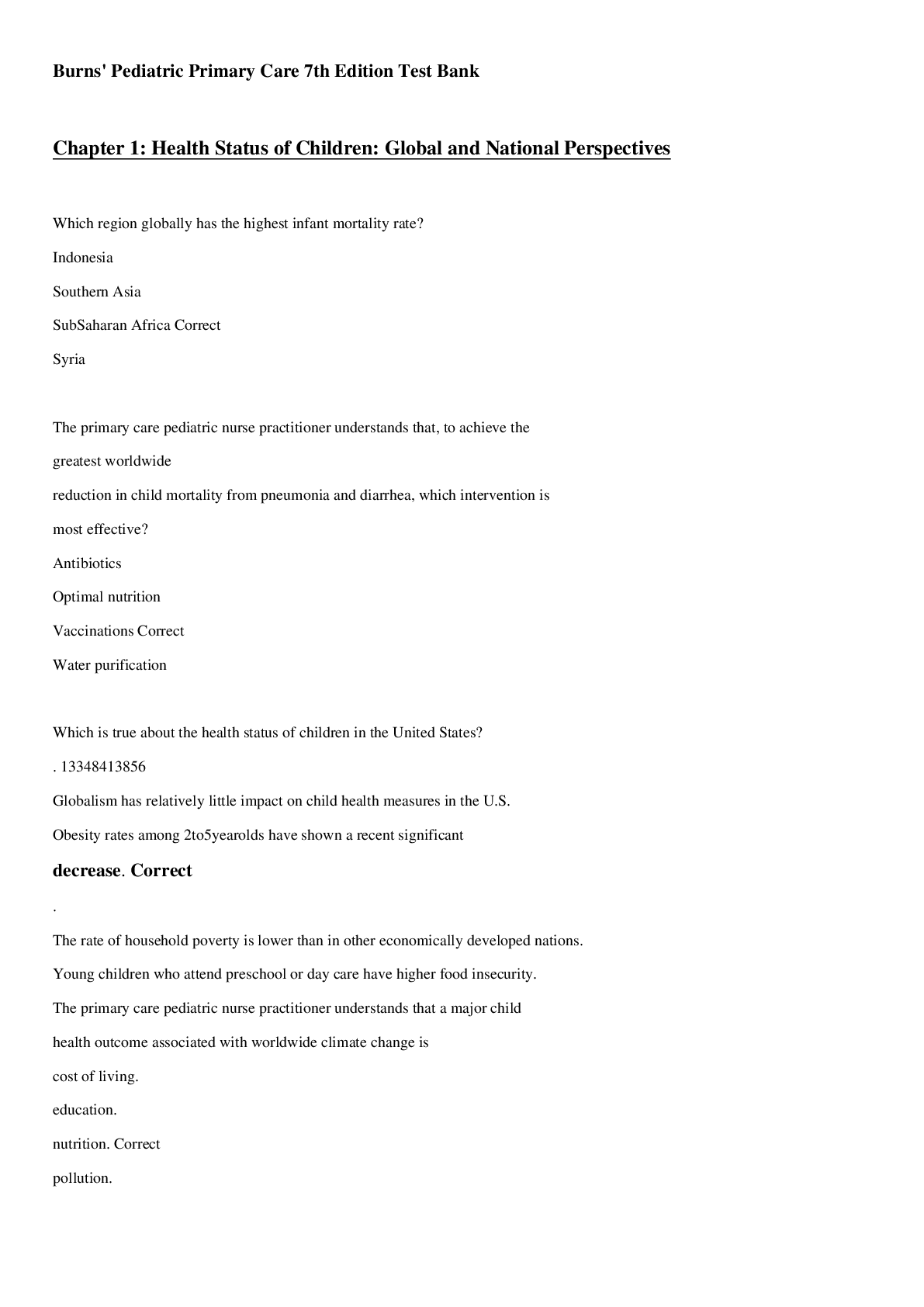
Buy this document to get the full access instantly
Instant Download Access after purchase
Add to cartInstant download
Reviews( 0 )
Document information
Connected school, study & course
About the document
Uploaded On
Nov 11, 2021
Number of pages
135
Written in
Additional information
This document has been written for:
Uploaded
Nov 11, 2021
Downloads
0
Views
75

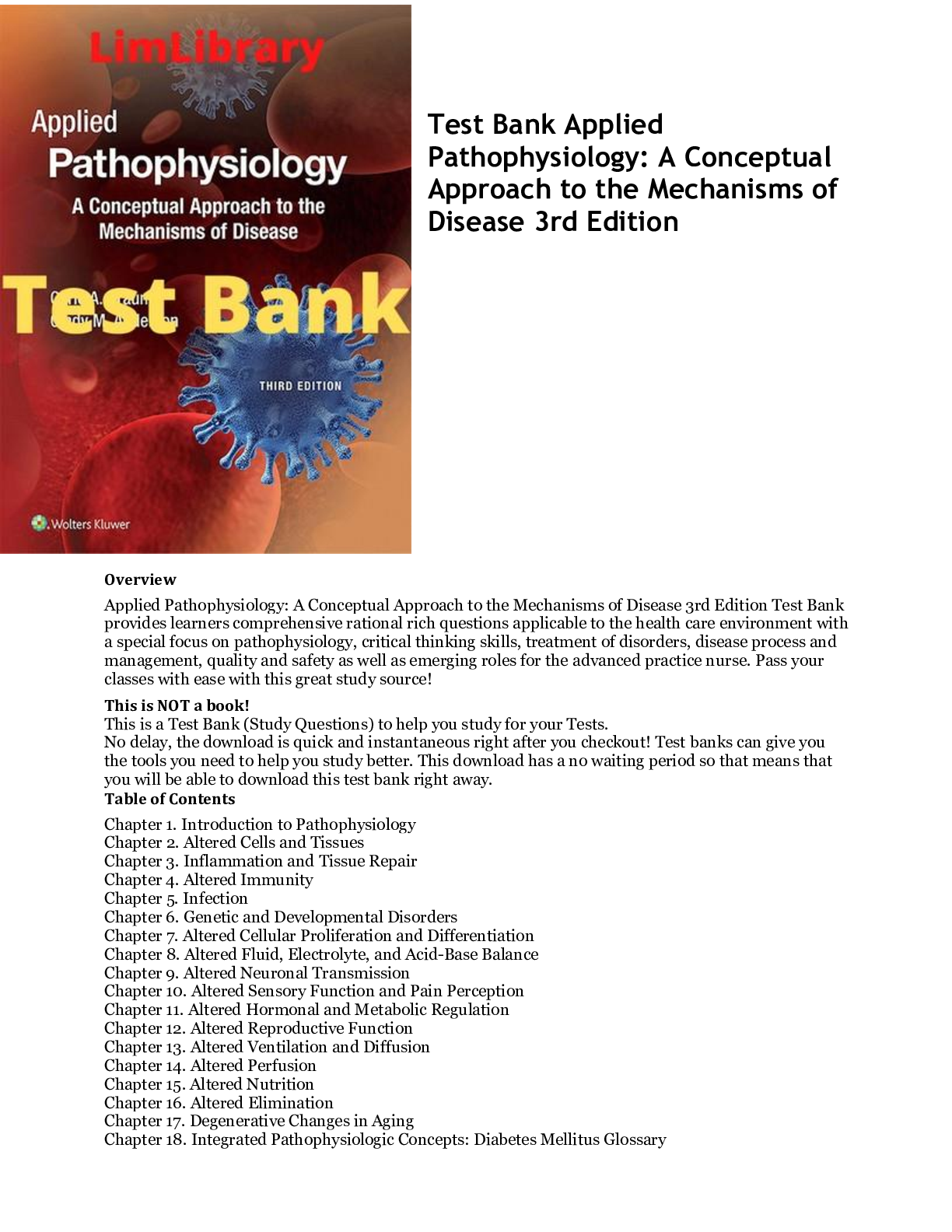

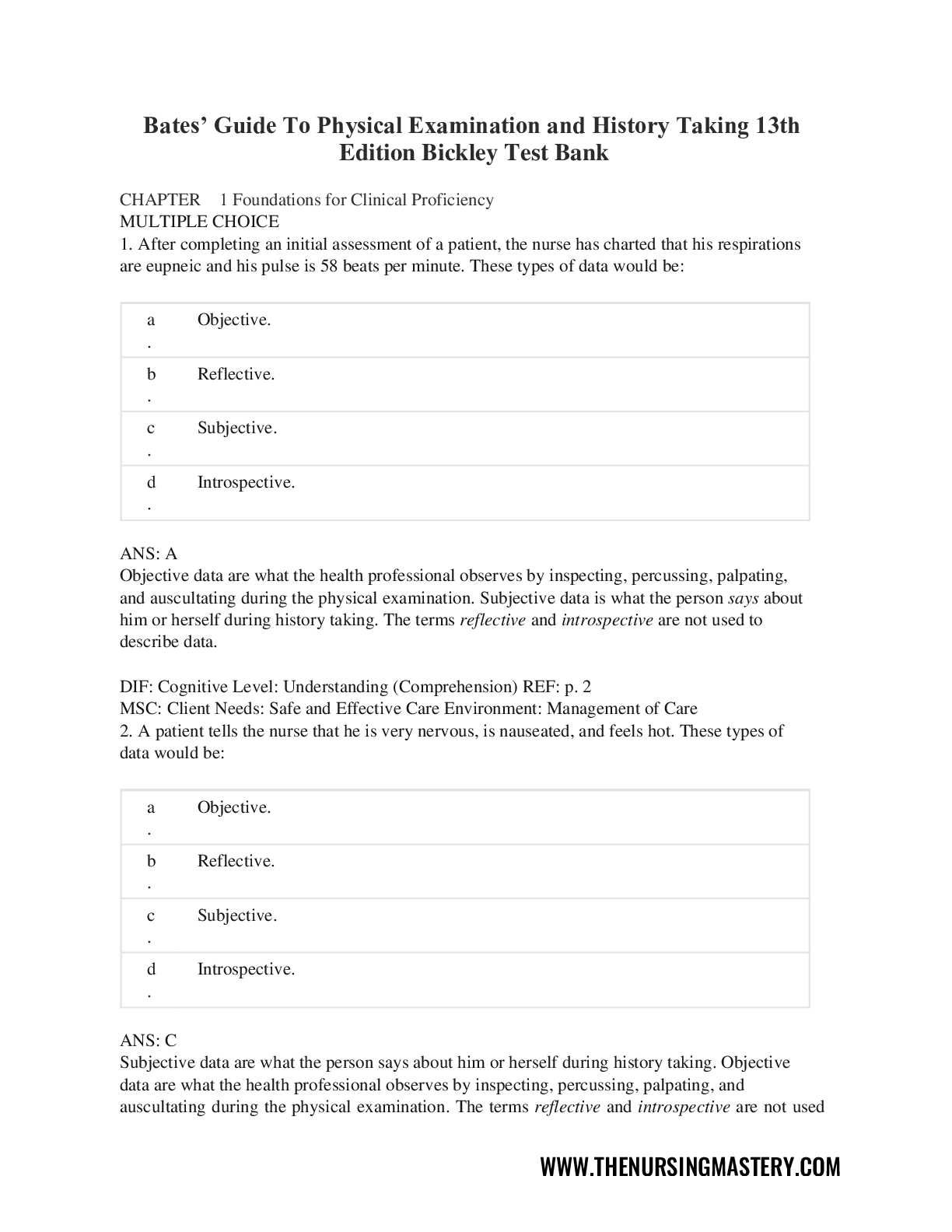
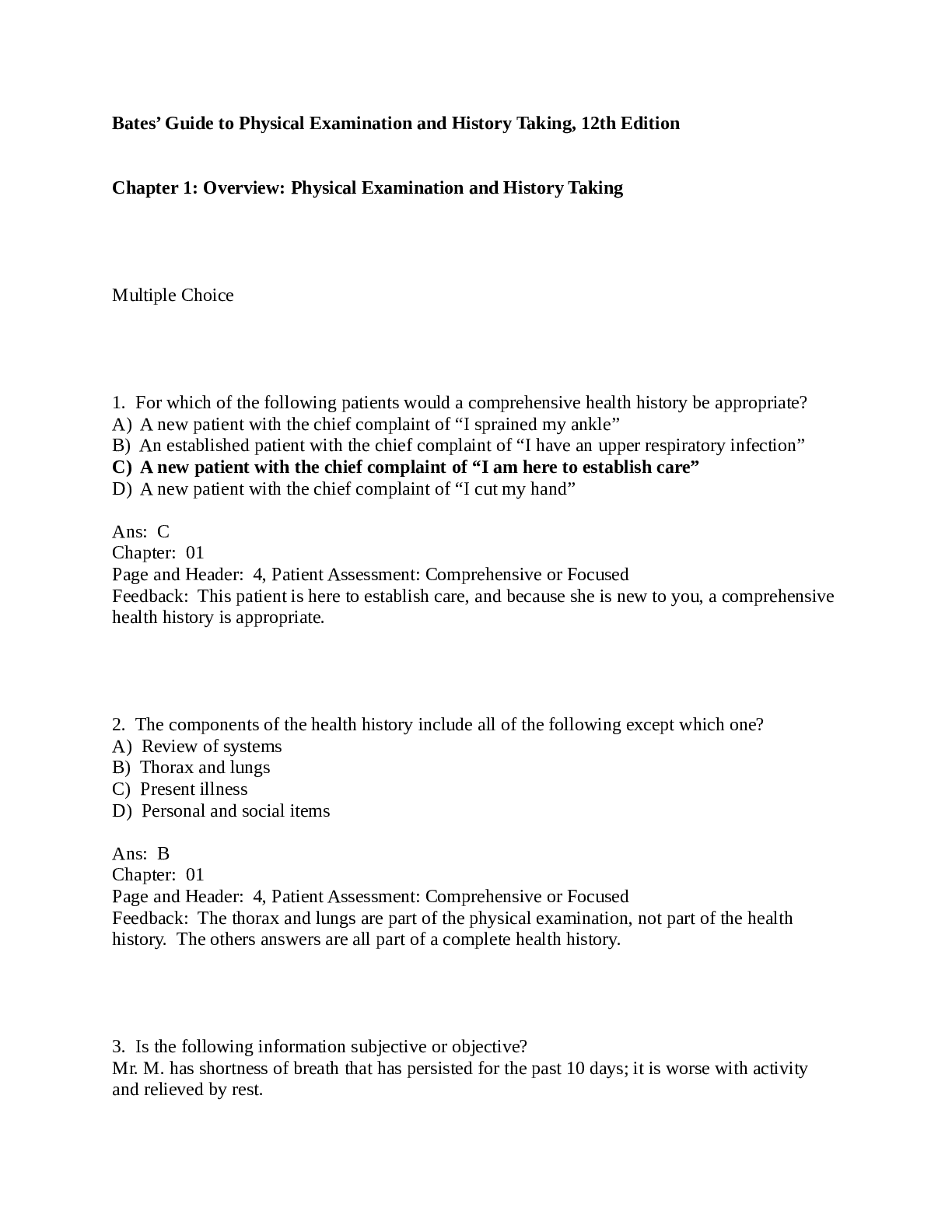
.png)
.png)
.png)

